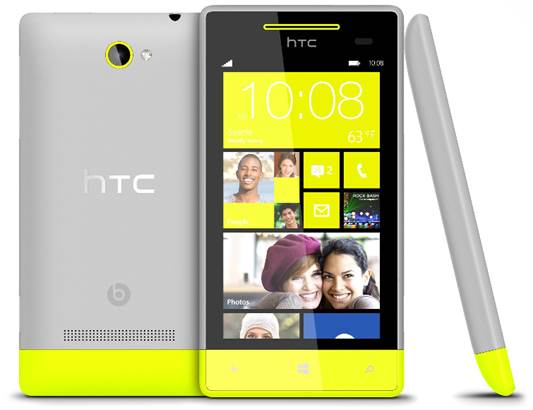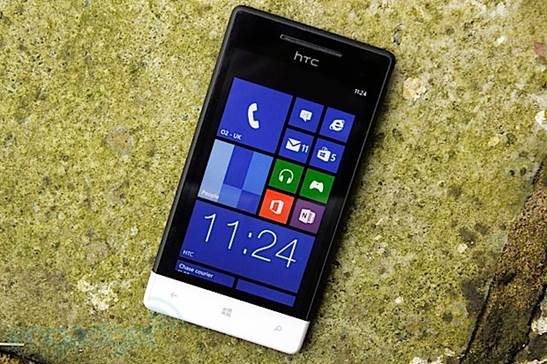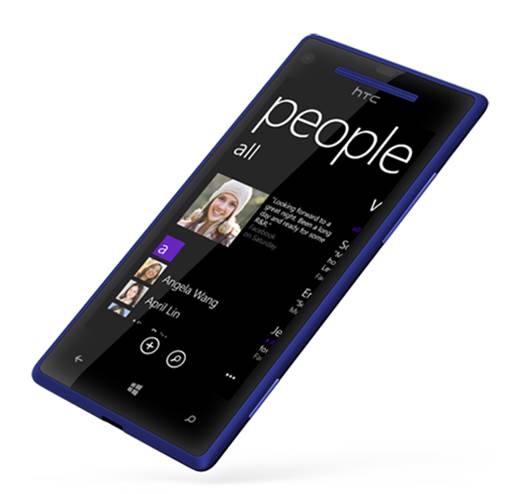HTC Windows Phone 8S
Flagship devices garner attention at the
top end of the smartphone market, but it's at the budget end where plenty of
money is made, so it's no surprise that both HTC and Nokia have released
impressive low-end devices.
HTC's effort, the Windows Phone 8S, makes a
striking first impression. Our review sample is decorated with a two-tone grey
and yellow color scheme. It’s downright ugly but, thankfully, HTC sells the 8S
in several other schemes - the black and blue, blue and white, and
bright-orange schemes all look far better.

HTC
Windows Phone 8S
Colors aside, the 8S's exterior is impressive.
Build quality isn't far away from the matte finish on the Nokia Lumia 620, and
its 10.3mm thickness and 113g weight - the lowest here ensure that the 8S won't
weigh down your pocket. The colored panel at the bottom of the phone clips off
to allow access to the micro-SD and SIM slots, but there's no way to access the
battery - an area where this handset falls behind the Lumia.
The HTC's screen shares its 480x800
resolution with the Lumia but, at 4" on the diagonal, it's a little
bigger. The quality is reasonable too, with its maximum brightness of 434cd/m2
not far behind the Lumia's 543cd/m2 panel. That means it's legible in bright
sunlight and, while the Nokia's screen is a little more punchy, we've no major
complaints about the HTC's screen.
HTC's handset is powered by a Snapdragon S4
running at 1GHz, and its SunSpider score of 1,410ms in a little ahead of the
Lumia's 1,449ms. The two phones shared similar scores in the Peacekeeper HTML
five test too, although the HTC props up our table - its result of 199 is a
little behind the Nokia's score of 219.
In real-world use, those middling benchmark
scores translated to perfectly acceptable performance, but the rest of the 8S's
specification isn't as impressive. There's no sign of NFC, its 802.11 n
wireless is only single band, and the 4GB of on-board storage is whittled down
to just 3.6GB of usable space once the OS has been installed. Be careful when
installing 3D games, then - that space could quickly disappear.

There’s
little to choose between the two handsets when buying on contract or SIM-free -
the 8S’s $ 275 price is only five pounds cheaper than the Nokia
It lags behind on the software front too:
while the 8S can use Nokia's HERE-branded maps, satnav and public transport
apps, Nokia's Music and City Lens tools remain exclusive to Lumia handsets. At
least the included software is good: maps can be downloaded for offline use,
and the satnav software is among the best that's available for free on phones.
There’s little to choose between the two
handsets when buying on contract or SIM-free - the 8S’s $275 price is only five
pounds cheaper than the Nokia. Both are good phones, but the Nokia has more
storage, a better screen and a more attractive, versatile design - so the Lumia
620 is our budget handset of choice in this test.
Details
·
SIM-free supplier: www..com
·
Manufacturer site: www.htc.com
HTC Windows Phone 8X
You wouldn't know it to look at the
adverts, but Microsoft chose HTC's Windows Phone 8X to be its lead device when
the OS was released at the back end of 2012. That means this phone is supposed
to embody everything that's impressive about Microsoft's new mobile OS - and
that means it's got a hefty weight of expectation on its polycarbonate
shoulders.

HTC
Windows Phone 8X
Thankfully, that polycarbonate construction
means this handset is good-looking and rock-solid. Its soft-touch blue finish
is comfortable, and we like the design: the gently convexed rear panel curves
around the edges to provide a border for the 4.3" screen, and its power,
volume and camera buttons are all the same blue color.
The 130g HTC is lighter than most of
Nokia's handsets, and it's 10.1mm thick slimmer than every phone here bar the
Lumia 820, and enough to ensure that the 8X feels extremely comfortable to hold
and use. The polycarbonate shell does have a downside, though, and that's a
lack of internal access - unlike the Lumia, you can't access the battery and
there's no micro-SD card slot.
The 8X's 4.3" screen shares its
diagonal with the Lumia 820, and its 720x1,280 resolution is higher than the
Nokia's 480x800 figure. It's far sharper than the Lumia, then, and it's better
in other departments: its measured brightness figure of 366cd/m2 beats the
Nokia's 301cd/m2. The Lumia has an AMOLED screen, so it's got better contrast,
but we prefer the brighter, more natural colors of the HTC's IPS panel.
The 8X shares its Snapdragon S4 Plus
processor with the Lumia 820, and both quad-core chips run at 1.5GHz. The HTC
delivered a SunSpider score of 913ms, which is one of the best in this group,
and its Peacekeeper result of 340 is also impressive; it's just one point
behind the table-topping Nokia Lumia 820.

Its
8MP camera is impressive too. Its images are packed with detail and colors are
vibrant, with only the Lumia 920 and its PureView shooter able to top the
quality on offer here
The impressive benchmarks translated to
slick Windows Phone 8 performance, and it handled games well too - none of our
test titles caused the HTC any problems. Battery life, at 50%, is middling: on
a par with the Lumia 820 and two other phones in this test.
Elsewhere, the 8X has a good specification:
dual-band 802.11n wireless, NFC, 1GB of RAM and 16GB of internal storage twice
as much as is on offer in the Nokia.
Its 8MP camera is impressive too. Its
images are packed with detail and colors are vibrant, with only the Lumia 920
and its PureView shooter able to top the quality on offer here.
The 8X impresses at the checkout too. It's
free on contracts that cost $39.6 a month, the same as the Lumia 820, and
SIM-free its $533 price is $32 less than the Lumia.
HTC's com ticks all the right boxes: the
same money as the Lumia 820, similar build quality and power, and with a better
camera and screen. It's an extremely well-balanced phone, and it’s the one to
buy if you want to invest in Windows Phone 8.
Details
·
SIM-free supplier: www..com
·
Manufacturer site: www.htc.com